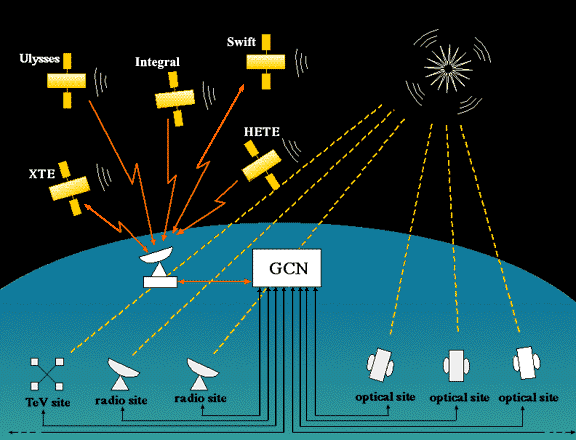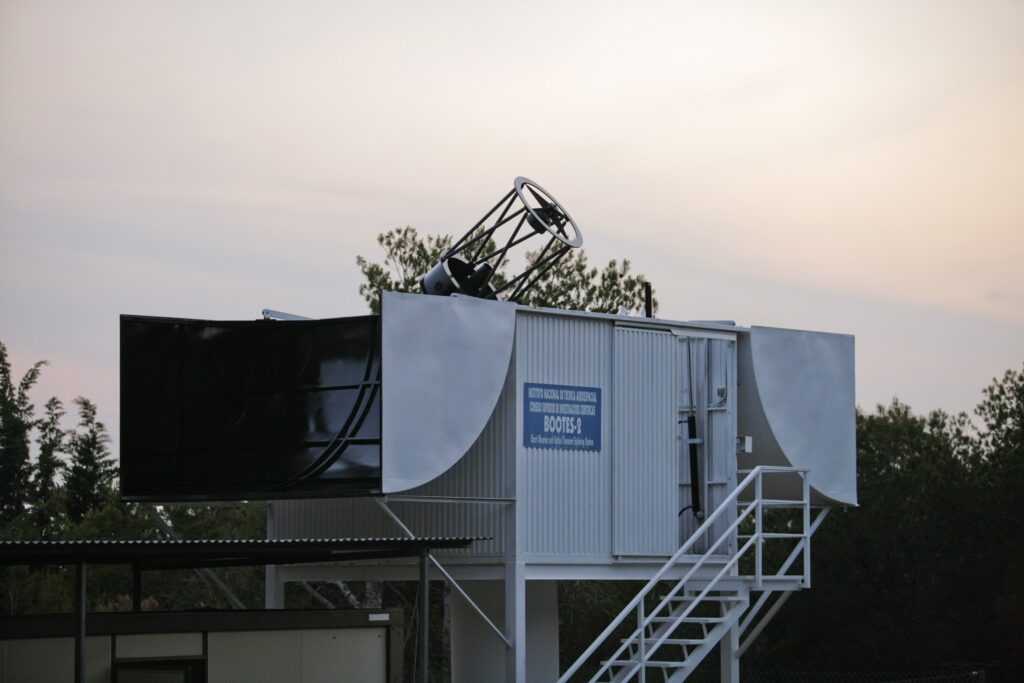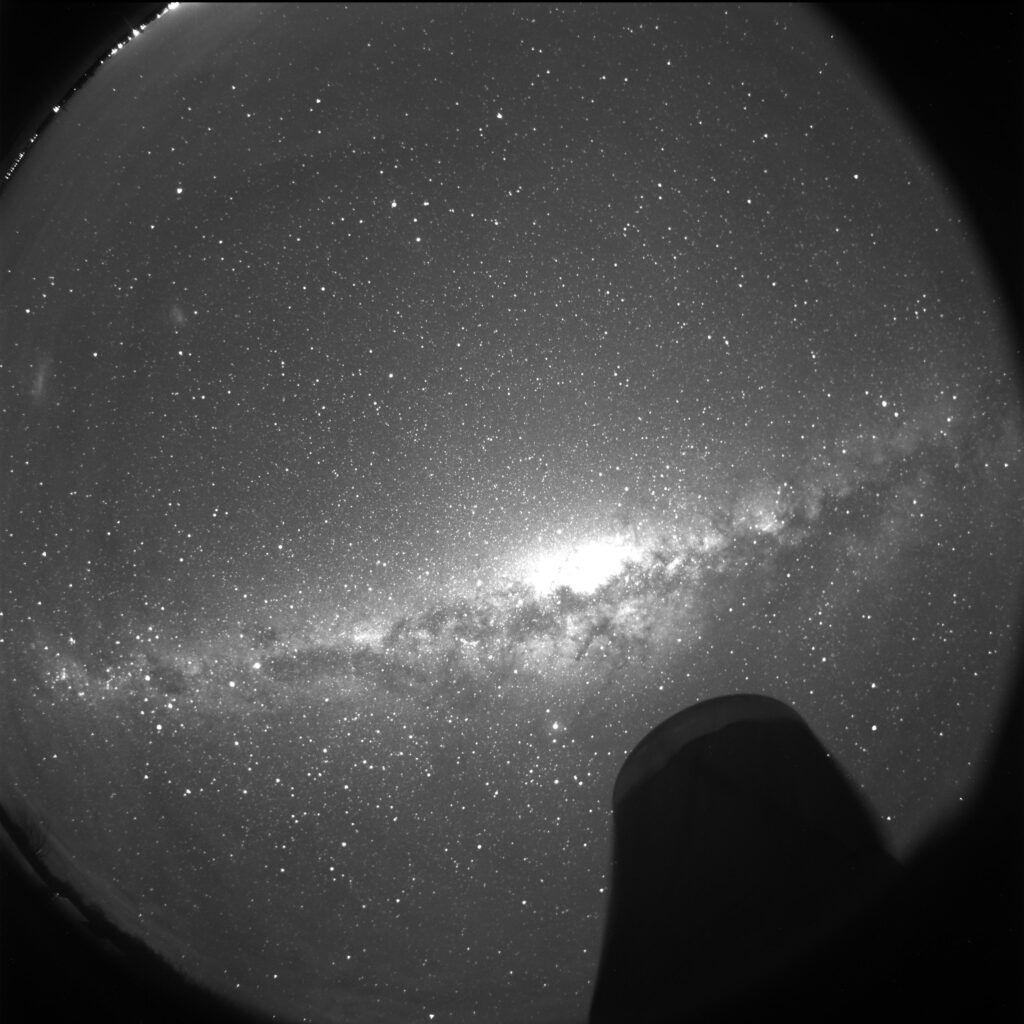1. INTRODUCTION
Since the beginning of mankind, the sky has been studied with interest and curiosity and, until very recently, as something static, or very slowly changing, because the available instrumentation did not allow us to observe immediately and with sufficient depth to be able to appreciate the evolution of transitory phenomena.
However, under the shelter of the space race, scientific satellites made it possible to explore other wavelengths beyond the visible, so that in 1969 the American satellites of the VELA1 series collected in their detectors 16 very strong increases in the number of gamma photons above the background level coming from sources outside the Solar System. After studying these increases, Ray Klebesadel, Ian Strong and Roy Olson (1973) announced the discovery of cosmic gamma-ray bursts (or GRBs, an acronym for Gamma-Ray Bursts).
2. COSMIC RAY BURSTS AND THE DISTANCE SCALE
GRBs appear as short bursts of high-energy cosmic photons (≥ 0.1 million electron volts), isotropically distributed on the celestial sphere, which pointed to their cosmic origin as early as the 1980s. Since then, groups of scientists and engineers around the world began to develop new instrumentation to study the phenomenon. They are now detected at a rate of about 100 per year, largely thanks to the purpose-built Swift satellite. The occurrence of GRBs is not periodic, but the events show temporal structure: ~25% are short (lasting on average 0.2 s) and of hard spectrum, compared to ~75% which are long (lasting on average 30 s) and of softer spectrum.
A fundamental step in deepening the understanding of GRBs was the detection of counterparts, at other wavelengths, associated with the phenomenon, and in particular in X-rays (as initiated by the BeppoSAX satellite in 1997), known as “afterglow”. This allowed the discovery of the first ones in the visible as early as that year. The luminosity of the visible counterparts decreases according to a power law with L α t^α (where -1.1 < α < -2.0). Since then, the following achievements of our team in the field can be summarised:

1. The first multi-range study of the GRB counterpart (980508), was achieved both on the ground (from millimetre lengths to the optical) and in space (ISO in the mid-IR and HST in the optical). The optical spectrum of the 2.2m CAHA telescope, the first obtained for a GRB, showed no emission lines and no variations on minute scales. According to the predictions of the fireball models for this multi-range (afterglow) emission, the intensity should increase monotonically up to the maximum, so we suggest that a different physical mechanism must be responsible for the detected constant brightness phase. Further observations with the 4.2m Herschel telescope on La Palma indicated the presence of an underlying constant-brightness object that we identified as the host galaxy where the GRB occurred, confirming the spectroscopic results (z = 0.8) obtained by another team with the 10m Keck telescope: GRBs occur at cosmological distances.
2. A detailed optical study of GRB 990123 revealed a 2-day deviation in the light curve of the optical residual, which was interpreted as the existence of collimated emission, and was later confirmed. The redshift derived from the spectrum (z = 1.6) implied an energy released during the outburst of 1054 erg. Polarimetric and millimetric observations were used to determine the emission maximum in the multi-range spectrum and allow the location of the three zones where the magnetic fields are generated.
3. Indication of the presence of an underlying supernova (SN) in GRB 980326 and later in GRB 991208. In this respect, the relation of long-lived GRBs to very energetic SNs was confirmed by the discovery of GRB 030329 by the HETE-2 satellite. This is the closest “classical” GRB detected to date (Fig. 1). As the days passed, the power-law optical spectrum typical of the initial afterglow revealed the typical spectrum of a supernova (SN 2003dh) similar to the energetic SN 1998bw (prototype of the new class of so-called “hypernovae”), leaving no doubt about the long-lived SN-GRB connection, pointing to the fact that the collapse of massive stars is closely linked to this class of GRBs. This was later confirmed by our spectroscopic and polarimetric observations of GRB 060218/SN2006aj.
4. Detection of the most distant object in the Universe (to date), GRB 090423, visible only in the near IR at redshift z = 8.2, which means that a stellar collapse occurred about 13 billion years ago and has been echoed back to us after travelling through space for all that time.

3. WHY A NETWORK OF ROBOTIC TELESCOPES.
The BOOTES project was one of the first to be developed to fill the gap in fast variability astronomy. If we add to this technology the ability to analyse the images obtained in real time, BOOTES becomes one of the most suitable and powerful instruments for the investigation of the Universe.
The Latin name of the constellation of the Buoy, BOOTES, serves as an acronym, in several languages2 , for the Project. BOOTES began as the first robotic observatory in our country, the result of an international collaboration3 in High Energy Astrophysics, and was conceived by the author of this article in 1996. The rest of the team was made up of scientists and engineers from Spanish and Czech institutes, who have been joined by scientists and technologists from other countries (Ireland, Ukraine, Venezuela) over the years. Its main raison d’être is the observation of counterparts in the visible of GRBs, but the scientific objectives are varied, from the daily observation of highly variable objects in our Galaxy and other galaxies to ground support for scientific satellites such as the ESA (European Space Agency) INTEGRAL gamma-ray observatory, as we will see later.
Thus, BOOTES was designed in 1996 to respond instantaneously and automatically, initially by means of two wide-field cameras (16º x 11º) consisting of 1024 x 1024 pix CCD detectors (SBIG ST-8) coupled to 50mm photographic lenses (at f/2.0). A third CCD camera with identical characteristics was attached to a 0.2m diameter telescope. On board the Compton gamma-ray observatory, the 8 BATSE detectors provided inaccurate GRB positions, with errors of several degrees of radius, so that the BOOTES wide-field cameras could image these areas down to a limit of magnitude 12. Deeper images would be obtained through the telescope itself, reaching a limiting magnitude of 18, although they would obviously only cover a tiny part of the error zone. The first light was obtained in July 1998 and since then, the technological developments in the development of the project have continued year after year.
Although BOOTES was originally intended as an instrument for GRB research, it has also participated in the study of meteor storms, recording a large number of fireballs and even other more peculiar phenomena that in some cases even caused confusion among the population.
During the first four years of operation, a large photometric database (mostly I-band) of more than 100 Gbytes has been generated in which to search for objects exhibiting short-period variations in various selected fields above declination -40º.
3.1. Scientific objectives
Although new evidence for the relation of long-lived GRBs to the collapse of supermassive stars has been accumulating in recent years, many details about the process and, above all, the origin of short-lived GRBs remain an enigma. To solve this, it is of utmost importance to be able to make quasi-simultaneous follow-up observations in order to detect transient emission associated with them. BOOTES is an instrument designed for such quasi-simultaneous follow-up observations and is thus making an effective contribution to our knowledge of these elusive phenomena. The main scientific objectives of the project are:
- Simultaneous and quasi-simultaneous observations of GRB error zones. In some cases, simultaneous images in the visible can reveal very bright counterparts (magnitude 9 as in the case of GRB 990123 or even magnitude 5 as in the case of GRB 080319), since the transient emission detected after the event is only a consequence of the expanding remnant left by the object. This remnant provides us with information about its environment but not about the object itself).
- Detection of optical flares of cosmic origin: Those that may not be GRB-related would consist of a new type of astrophysical phenomenon (perhaps related to quasi-stellar objects and other active galactic nuclei or active corona stars – dwarfs with emission lines). In cases where GRB-related, several theoretical models predict that there would be many events with only transient X-ray and visible emission, because the gamma-band emission is confined to a jet structure.
In addition, there are important secondary scientific fields that can also be pursued under the umbrella of the project, among them:
- Asteroid occultations of stars to determine various parameters.
- Detection of extrasolar planets either by the transit method or by gravitational microlensing techniques.
- Regular observation of transient and variable objects in our Galaxy, such as variable stars of various classes (Algol, Mira, AM Her, delta Scuti, etc.) and even novae.
- Regular observation of supernovae previously discovered at other observatories to follow their light curves, etc.
- Regular observation of blazars.

3.2. The robotic stations of the BOOTES Project in Spain
Our group is a pioneer in Spain in the field of robotic astrophysics. Thus, under the auspices of INTA initially and later of IAA-CSIC, the first two BOOTES observing stations were designed and built, which are located in Andalusia.
The first one (BOOTES-1) is located at the Arenosillo Experimentation Centre of the National Institute of Aerospace Technology (INTA) in Mazagón, Huelva. The second station is at the La Mayora Experimental Station of the Spanish National Research Council (CSIC) in Algarrobo Costa, Malaga. The coordination of both stations and their scientific exploitation is carried out from the Instituto de Astrofísica de Andalucía of the CSIC in Granada.
In 2001 BOOTES was expanded with a second station located 200 km away: BOOTES-2 at the CSIC experimental station of La Mayora. As a complement to this research, in 2002 we developed an all-sky camera whose design was patented in 2005 and licensed to a Spanish company in 2007.
The reason that BOOTES-1 is located in Mazagón (Huelva), while BOOTES-2 is located in Algarrobo Costa (Málaga) is not by chance. Apart from the large number of clear nights in these two Andalusian locations, the fact that the two stations are 240 km apart is important. By using identical instrumentation and simultaneously observing the same field of the sky, BOOTES obtains a stereoscopic view, so that it can, by means of parallax, discriminate those detected sources whose origin is close to the Earth (< 106 km).
The elements that currently make up the BOOTES-1 equipment at Arenosillo (Huelva) are:
BOOTES-1A: Schmidt-Cassegrain reflecting telescope (Ø = 0.2-m f/6.3), with 1524 x 1024 CCD MI camera at Cassegrain focus attached to the optical tube, with 30′ x 20′ field. It will soon be replaced to house the prototype of the “Pi-of-the-Sky North” experiment in collaboration with the University of Warsaw (Poland).
BOOTES-1B: Schmidt-Cassegrain reflecting telescope (Ø = 0.3-m f/10), with a 1524 x 1024 pix MI CCD camera at Cassegrain focus, with a field of 20’x13′, and the CASANDRA-1 “all-sky” camera with a 4096 x 4096 pix Alta U16 CCD. It also has a 400mm lens attached to a 4096 x 4096 pix High U16 CCD, which covers a field of 5º x 5º.
Under the shelter of this intelligent robotic observatory, the “I National Meeting on Robotic Astrophysics” was held in Mazagón – where the BOOTES-1 station is located – in 2004, the germ of the “Workshop on Robotic Autonomous Observatory” held in Malaga at an international level in 2009.
The elements that currently make up the BOOTES-2 scientific station in Algarrobo Costa (Malaga) are: TELMA (TELescopio MAlaga): Schmidt-Cassegrain reflecting telescope (Ø = 0.6-m f/10), with ultra-fast NTM-502 mount (German type), with Andor Ixon DU-888 high-speed readout camera attached to the Cassegrain focus, with g’r’i’ZY filters, and 10′ x 10′ field, and the CASANDRA-2 “all-sky” camera equipped with a 4096 x 4096 pix Alta U16 CCD. See Fig. 4.
In order to extend its scientific objectives, the BOOTES-IR station was inaugurated in 2004 at the Sierra Nevada Observatory in Granada, with a Schmidt-Cassegrain reflecting telescope (Ø = 0.6-m f/10), with an ultra-fast altazimuthal mount and a near-infrared optimised BIRCAM camera, with a 1024 x 1024 pix detector and JHKs filters, and a 13′ x 13′ field. The first IR light was obtained in 2007.
3.3 Expansion to other parts of the world
In February 2009 and with the presence of the Spanish ambassador in New Zealand, we inaugurated a robotic astronomical station twin to the Spanish BOOTES-2, in the South Island of New Zealand (BOOTES-3), so that we can now have access to the southern hemisphere being able to respond to satellite alerts autonomously. The elements that currently make up the BOOTES-3 science station in Blenheim (New Zealand) are: YA telescope (Yock-Allen telescope): a Schmidt-Cassegrain reflecting telescope (Ø = 0.6-m f/10), with an ultra-fast NTM-502 mount, a high-speed Andor Ixon DU-888 camera attached to the Cassegrain focus, with g’r’i’ZY filters, and a 10′ x 10′ field, and the CASANDRA-3 “all-sky” camera with a 4096 x 4096 pix Alta U16 CCD. See Fig. 5.

3.4. Scientific results
Since the first light in 1998, observations of more than 100 GRBs have been obtained to date, sometimes starting as early as 30 s after the onset of the GRB. A large number of GCN circulars as well as about ten papers published in refereed journals have been published. The two most important results are the detection of a transient source in the visible, a candidate to be the counterpart of the short-lived GRB GRB GRB 000313 (Fig. 6), and the simultaneous observations of events at the edge of the observable Universe: GRB 050904 and GRB 090423.
Apart from observations in the GRB field, BOOTES collaborates in the study of gravitational microlensing, monitoring of variable objects (such as blazars), etc. Also, the CASANDRA cameras are part of the Spanish Meteor and Bolide Network (SPMN). These studies include dual-station observations and the evolution of meteor trails in the upper atmosphere.

3.5 Future goals
The development of new instrumentation for BOOTES will continue. We are currently developing the low-resolution spectrograph COLORES which we expect to be implemented in 2011 at the Cassegrain focus of the 0.6m diameter TELMA telescope at the BOOTES-2 astronomical station.
Similarly, the idea of a Global Robotic Telescope Network is being pursued, with the robotic astronomical station BOOTES-4, twinned with BOOTES-2 in Spain and BOOTES-3 in New Zealand, to be installed in Siberia (Russia) in May 2011.
In June 2011 we will organise the “II Workshop on Robotic Autonomous Observatory” which will also be held in Malaga.
Similarly, and in collaboration with other institutions (University of Warsaw, Poland, and the Special Astrophysical Observatory of the Russian Academy of Sciences) we intend to install in the near future two prototypes (“Pi-of-the-Sky North” and “MegaTortora”) so that the BOOTES-1 Station can become a reference for Large Field Astronomy in the Northern Hemisphere.
4. SUMMARY
The monitoring and study of cosmic gamma-ray bursts is one of the fields of astrophysics where the contribution of non-professional astronomers can be greatest, due to the high possibility of detecting the optical afterglow of GRBs if we act quickly enough to observe it as soon as the initial gamma-ray emission has been localised in the sky.
Within the scope of the BOOTES Project, we intend to dedicate part of the observing time (both BOOTES-2 and BOOTES-3) to citizen science and outreach through the Internet in the framework of the GLORIA Project applied for in the framework of the EU FP-7 programme and therefore one of our wishes would be that the non-professional community in Spain would benefit from it.